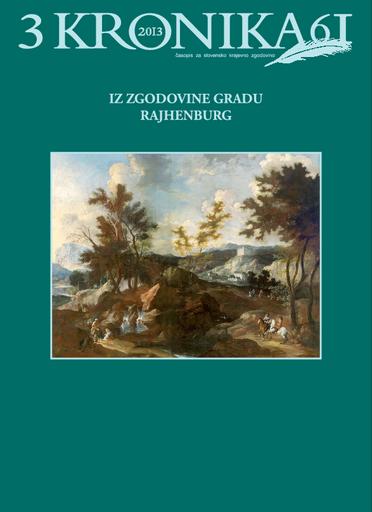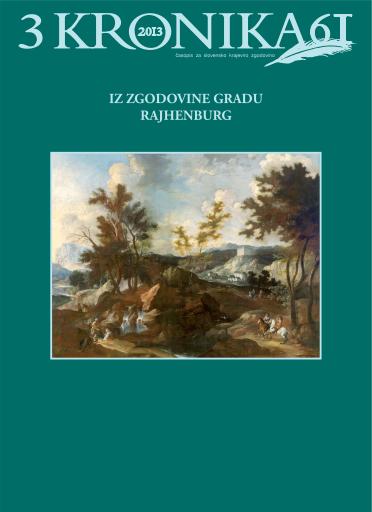/
Serijske publikacije
/
Kronika: časopis za slovensko krajevno zgodovino
Rajhenburg in listina kralja Arnulfa za Valtunija iz leta 895

Avtor(ji):Peter Štih
Soavtor(ji):Miha Preinfalk (odg. ur.), Barbara Šterbenc Svetina (teh. ur.), Alenka Cizel (prev.), Manca Gašperšič (prev.), Andreja Jankovič Deržič (prev.), Dejan Zadravec (prev.), Lidija Slana (prev.), Meta Osredkar (prev.), Agencija MultiLingual (prev.), Irena Bruckmüller Vilfan (prev.)
Leto:2013
Založnik(i):Zveza zgodovinskih društev Slovenije, Ljubljana
Vir(i):Kronika, 2013, št. 3
Jezik(i):slovenščina
Vrst(e) gradiva:besedilo
Ključne besede:Arnulf, Valtuni, D. Arnolf 138, Rajhenburg, Krško, Krka, Hema, Arnulf, Waltuni, D. Arnolf 138, Rajhenburg, Krško, Gurk, Hemma
Avtorske pravice:

To delo avtorja Peter Štih je ponujeno pod Creative Commons Priznanje avtorstva-Nekomercialno-Brez predelav 4.0 Mednarodna
Datoteke (1)

Ime:kronika-2013_3.pdf
Velikost:66.73MB
Format:application/pdf
Stalna povezava:https://hdl.handle.net/11686/file18349
Opis
Prispevek obravnava listino kralja Arnulfa za Valtunija, izstavljeno v Öttingu 29. septembra 895 (D. Arnolf
138), ki je ohranjena v prepisu v kopijalni knjigi škofije v Krki na Koroškem s konca 12. stoletja. Na podlagi
raziskav in mnenj številnih zgodovinarjev, ki so se od poznega 19. stoletja ukvarjali z obravnavano listino, je
pokazano, da je tisti del, ki govori, da je Valtuni dobil posest v Rajhenburgu (današnja Brestanica) v »marki ob
Savi« in v Krškem (polju), kasnejši vrinek in da je listina ponarejena.
Metapodatki (12)
- identifikatorhttps://hdl.handle.net/11686/34993
- naslov
- Rajhenburg in listina kralja Arnulfa za Valtunija iz leta 895
- Rajhenburg and the charter of King Arnulf for Waltuni of 895
- ustvarjalec
- Peter Štih
- soavtor
- Miha Preinfalk (odg. ur.)
- Barbara Šterbenc Svetina (teh. ur.)
- Alenka Cizel (prev.)
- Manca Gašperšič (prev.)
- Andreja Jankovič Deržič (prev.)
- Dejan Zadravec (prev.)
- Lidija Slana (prev.)
- Meta Osredkar (prev.)
- Agencija MultiLingual (prev.)
- Irena Bruckmüller Vilfan (prev.)
- predmet
- Arnulf
- Valtuni
- D. Arnolf 138
- Rajhenburg
- Krško
- Krka
- Hema
- Arnulf
- Waltuni
- D. Arnolf 138
- Rajhenburg
- Krško
- Gurk
- Hemma
- opis
- Prispevek obravnava listino kralja Arnulfa za Valtunija, izstavljeno v Öttingu 29. septembra 895 (D. Arnolf 138), ki je ohranjena v prepisu v kopijalni knjigi škofije v Krki na Koroškem s konca 12. stoletja. Na podlagi raziskav in mnenj številnih zgodovinarjev, ki so se od poznega 19. stoletja ukvarjali z obravnavano listino, je pokazano, da je tisti del, ki govori, da je Valtuni dobil posest v Rajhenburgu (današnja Brestanica) v »marki ob Savi« in v Krškem (polju), kasnejši vrinek in da je listina ponarejena.
- The paper focuses on the charter of King Arnulf for Waltuni, issued in Ötting on 29 September 895 (D. Arnolf 138). The document has been preserved in a transcript in the cartulary of the Bishopric Gurk, Carinthia, from the end of the 12th century. Based on the research and opinions of many historians who have dealt with the said charter since the late 19th century, it has been demonstrated that the part that speaks of Waltuni receiving in possession an estate in Rajhenburg (present-day Brestanica) in the »March along the Sava River« and in Krško, was a later insertion and that the charter was falsified.
- On 29 September 895, King Arnulf issued in Ötting, Bavaria, a charter granting his loyal vassal Waltuni an estate in Trixental and Diex in Carinthia, three royal manses in Rajhenburg in the March along the Sava River, a Krško (Germ.: Gurkfeld) estate on the opposite bank of the Sava River, and an estate in the upper Mura River basin in Ingering, previously the fief of a certain Ottelin. The granted estate was situated in the county of Luitpold, in the eastern parts known as Carantania. The charter is important for Slovenian history for several reasons. Richenburch was ascribed the epithet of the oldest castle documented in the Slovenian territory. In a similar vein, Richenburch and Gurcheuelt became the oldest German place names south of the Karavanke mountain range and the Lower Styrian Drava River. What is more, containing an indication of a March along the Sava River (marchia iuxta Souwam), the said charter is the sole document to have recorded the name of the Carolingian County (Margraviate) in the Lower Slovenian Sava River basin throughout the entire 9th century; in addition, its indication of a castle, three royal manses on the left and an estate on the right bank of the Sava River points to the first beginnings of organising land estates on the western model and hence the beginnings of feudalisation south of the Drava River. And finally, according to the charter, the southeastern part of Carantania reached in the 9thand possibly already in the 8thcentury as far as the Lower Styrian Sava River and beyond. The charter, preserved in a single transcript in cartulary of the Bishopric Gurk from the end of the 12th century (Gurker Kopialbuch 1, AT-KLA 118, Geschichtsvereins-Handschriften 2/24, fol. 1v, 2r), has long confronted historians with a series of problems. The discussion, in which special mention should be made of Moritz Felicetti von Liebenfelss, Andreas Mell, Hans Pirchegger and August Jaksch, first primarily focused on the question whether the diction in comitatu Livpoldi in orientalibus partibus Charanta nominatis refers only to the estate in Ingering, the last one listed above, or to all three estate clusters. This gave rise to the question regarding administrative organisation of Carantania, which is now deemed to have encompassed one single county in 976 and which was at the end of the 9th century administered by Luitpold, the second most powerful figure after King Arnulf in the southeastern portion of the kingdom. Equally dubious was the datum that the estate along the Lower Styrian Sava River was part of Carantania. Due to the fact that the geographical sequence was broken by the interference of the estate far in the south along the Sava River, as well as for stylistic reasons, Ernst Klebel was the first to suspect in the early 1950s that this particular passage might have been a later interpolation into the text of the charter. His opinion was endorsed and further reinforced by Kurt Reindl. The crucial turning point then occurred in the 1990s, when Herwig Wolfram successfully demonstrated that, both linguistically and institutionally, the marchia iuxta Souwam did not belong to the 9th century but at the earliest to the 11th century. This led to the unequivocal conclusion that the charter had been tampered with or falsified – the only question that remained was to what extent. Hans-Dietrich Kahl then managed to demonstrate with compelling arguments that the passage in marchia iuxta Souwam tres regales mansos, quod Richenburch dicitur should be stricken out from the charter, as well as most likely the following wording: et aliud predium ultra fluvium Sowam Gurcheuelt nuncupato. The research conducted so far shows that the only Carantanian estate Waltuni received in 895 was that in Carinthia and Upper Styria and that the charter cannot be used in the discussion on the southern or southeastern border of Carantania. Therefore, according to the present knowledge, no crown grant was issued for the territory south of the Drava and east of the Isonzo before the second half of the 10th century. The March along the Sava River was institutionally and nominally proven a phantom form, with Carniola remaining the only historical provincial name documented for the Slovenian Sava River basin in the early Middle Ages. Furthermore, there is no longer any ground to believe that the beginnings of organising land estates in the said area date back to the Carolingian period. Similarly different were the beginnings of Rajhenburg and Krško, which can thus no longer be considered the oldest German place names south of the Karavanke mountain range and the Drava River, just as Rajhenburg can no longer be regarded the oldest castle. Rajhenburg, renamed Brestanica in 1953, was thus first documented in 1043, when it passed into the hands of the Archbishopric of Salzburg, and obtained its first castle only about 1130 under Archbishop Conrad I.
- založnik
- Zveza zgodovinskih društev Slovenije
- datum
- 2013
- tip
- besedilo
- jezik
- Slovenščina
- jeDelOd
- pravice
- licenca: ccByNcNd
